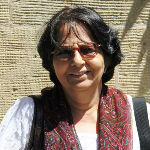 Himanshu Prabha Ray is former Chairperson of the National Monuments Authority, Ministry of Culture, and former Professor, Centre for Historical Studies, Jawaharlal Nehru University, New Delhi. As a recipient of the Anneliese Maier research award of the Humboldt Foundation in 2013, she is affiliated to Ludwig Maximillian University, Munich. She is also editor of Archaeology and Religion in South Asia in the Routledge Series.
Himanshu Prabha Ray is former Chairperson of the National Monuments Authority, Ministry of Culture, and former Professor, Centre for Historical Studies, Jawaharlal Nehru University, New Delhi. As a recipient of the Anneliese Maier research award of the Humboldt Foundation in 2013, she is affiliated to Ludwig Maximillian University, Munich. She is also editor of Archaeology and Religion in South Asia in the Routledge Series.
Her books on maritime history include Beyond Trade: Cultural Roots of India’s Ocean, Aryan Books International, 2015; The Archaeology of Seafaring in Ancient South Asia, Cambridge University Press, 2003, as also edited volumes, Satish Chandra & Himanshu Prabha Ray, The Sea, Identity and History: From the Bay of Bengal to the South China Sea, Manohar Publishers, 2013; H.P. Ray & E.A. Alpers, Cross Currents and Community Networks: Encapsulating the History of the Indian Ocean World, Oxford University Press, New Delhi, 2007; H.P. Ray & J.-F. Salles, Tradition and Archaeology: Early Maritime Contacts in the Indian Ocean, Manohar Publishers, New Delhi, 1996 (updated edition 2012).
Abstracts of the lectures
Indian society and its contacts with other societies and cultures: the evidence from archaeology and epigraphy
This series of four lectures is structured around two objectives: one, to highlight the role of disciplines such as archaeology in the study of the past, starting with the Constitution of India; and second to discuss a range of sources that are useful in an understanding of India’s contacts with other societies.
Lectures:
- Our Founding Fathers – Archaeology and the Constitution of India: The first lecture draws on Constituent Assembly debates prior to India’s independence in 1947 to discuss the reasons for the choice of the Sarnath lion capital as a national symbol for the new nation. What impact did archaeological excavations conducted in the 19th and 20th century in the country, have on this selection?
- Fishing and Sailing Communities: the bedrock of maritime activity: Fishing communities are seldom represented in literary sources and their presence in the archaeological record has only recently been noticed, though their role in maritime contacts in the Indian Ocean in antiquity is undeniable.
- ‘Reading’ coastal monuments and cultural diversity: Monumental architecture along the coasts served dual functions, as these provided linkages with travelling groups who moved both across the sea, as well as on routes into the interior; and second, they were used as major orientation points by watercraft while approaching land, for example, the Konarak temple in Odisha referred to as the Black Pagoda.
- Inscriptions across the oceans: Starting from the beginning of the Common Era a range of written material in languages such as Sanskrit, Prakrit and Tamil travelled across the seas. This final lecture will provide an overview of not only stone inscriptions, but also those on pots and other artefacts.
Readings
- Himanshu Prabha Ray, The Choice of National Symbols and Cultural Unity, Sabyasachi Bhattacharya, (ed.), Cultural Unity of India, Ramakrishna Mission Institute of Culture, Kolkata, 2013: 373-402.
- Himanshu Prabha Ray, Beyond National Boundaries, Introduction to Satish Chandra and Himanshu Prabha Ray, (eds), The Sea, Identity and History: From the Bay of Bengal to the South China Sea, Manohar Publishers, 2013.